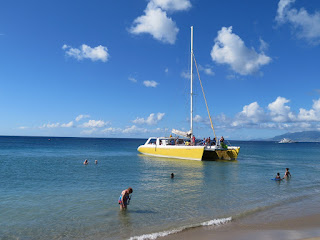The Commonwealth of Dominica is part of the Windward
Islands and has essentially the same history from the time the first Europeans
arrived on the scene as the other islands we visited. It is the youngest island
in the region with active volcanoes still adding to the island. Due to its age, the beaches are less desirable
than on the other islands and tourism has had a slow start here.
It is one of the poorest islands in the Caribbean,
but is known for its lush rainforests, which cover much of the inland. These
areas attract a significant number of nature tourists.
We opted for
a cultural tour of the island to enjoy the scenic overlooks, the rainforests,
waterfalls and some of cultural and historic sites.
Our first stop was the President's office and
conference center. In late 1978, the island obtained its independence from England
and formed a democratic government.
While there were some conflicts early in the process, the same system of
government remains today. With the colonial
government gone, the Royal Governor's home built in the 1800's has become the
office and conference center for the President.
Our guide indicated that there has been a great deal of money spent on
restoration and upgrades.
We then headed into the mountains and had great
views of the capital from the site of a former British fortification.
The botanical gardens is a popular spot for
residents to stroll or relax and enjoy some of the unique local plants. Our guide provided many insights to the
plants and their history. The cannonball
tree came by that name during the conflicts between the French and English when
the defending forces were short on cannonballs. The fruit of this tree has a
very hard shell, which they used in their cannons, according to our guide. It also has beautiful flowers in season,
which we did not get to see. What I
found interesting was the 100 year palm tree.
This tree lives approximately 100 years and does not bloom until it is
about to die. One of these was blooming
while we were there. Our guide said it
will be gone within the month and was approximately 80 years old. In the gardens, there is an impressive
reminder of the power of hurricanes. A bus was parked at the gardens when hurricane
David arrived in 1979. A 21 foot diameter
African Baobab tree fell on the bus and crushed it flat. Fortunately, no one
was in the bus at the time.
Climbing high in the rainforest, our next stop was Trafalgar
Falls. This is one of the top
attractions on the island and is reached by walking up a a marked trail from
the visitor center. It is a 20 minute
hike, depending on conditions, yours and the weather's. It rained on and off most of the time, but
after all, it is a rainforest. The falls
were interesting but certainly nothing truly remarkable. Watching some folks climb around on the
slippery rocks was more entertaining. Our guide indicated there are injuries on
the rocks on a near daily basis.
After the falls visit, we stopped at a nearby restaurant for some light
refreshments and a great view of the rainforest and a nearly steady mist to occasional
downpours.
Lastly, we headed back to the capital city of Roseau,
where our ship was docked. Along the way. we got a glimpse of the city sights.













































































